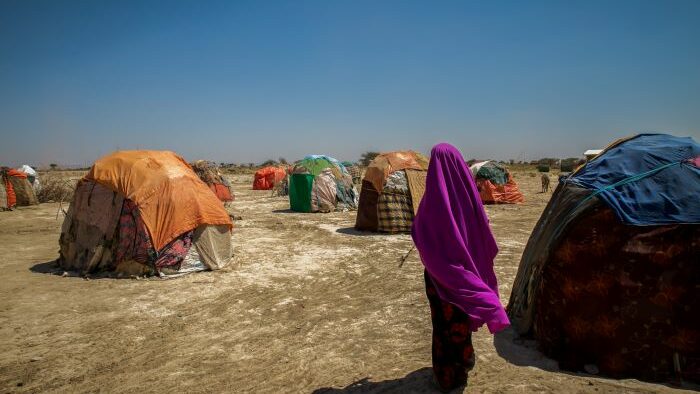Summary: As the planet continues to warm, forced migration is growing in places least responsible for the climate crisis and people’s ability to cope is dwindling. A 1 °C warming is estimated to lead to a ten-fold increase in expected displacement.
In 2020 alone, weather and climate related events resulted in the forced migration of an estimated 30 million people, according to the Internal Displacement Monitoring Centre. Of those, over 6.5 million were in the Horn of Africa. As the climate crisis continues to exacerbate, what does this mean for those populations in climate vulnerable and conflict-affected countries?
Research from a team at Climate Econometrics at the University of Oxford, the University of Victoria, and Princeton University, takes a new approach to this question. While many studies use national data, the new study uses vastly more localised data from the 18 separate regions in Somalia with detailed reporting on the reason that displaced people leave their homes. The unique granularity of the displacement data has allowed the authors to gain a more detailed understanding of how weather and conflict is forcing internal populations to migrate.
“Much has been said about the impacts from climate change though less is known about the scale at the local level. We put numbers to anecdotes, teasing out whether drought or conflict plays a more significant role in forcing people to flee” lead author Dr Lisa Thalheimer explains.
Unsurprisingly, weather shocks in the form of higher temperatures or decreased precipitation do impact displacement within the country. The more alarming finding is that even a marginal effect has a huge impact, highlighting the likely effect that climate change has on vulnerable areas.
An increase in temperature anomalies by even 1 °C leads to an approximate ten-fold (1098%) increase in expected displacement. The same effect is found for a lack of rainfall, something that happens frequently across the Horn of Africa region. If average monthly rainfall declines from 100mm to 50mm, predicted numbers for internally displaced populations in Somalia double.
Conflict, on the other hand, has been harder to understand because its effects in the aggregate are masked when combined with other self-reported reasons for migration, like weather, for example. Once it is teased out and isolated as a response which is possible in this unique dataset, conflict is found to be a major driver of displacement as populations seek safety in other regions.
“Crucially, we find little effect of incoming displaced people on conflict itself” describes Dr Felix Pretis, an author on the study. This finding dispels the common myth that displacement might further fuel conflicts.
One of the most important things to understand is that the impacts of climate change already being felt by these vulnerable regions is likely to get worse, a trend that also already affects the Global North. This study provides support for initiatives aiming to provide evidence-based information on humanitarian crises before another hazard or conflict situation turns into a disaster. Only by understanding the drivers of displacement can effective policies be implemented, even in an anticipatory mode.
The policy implications of the papers can be summarized as “diverting more funding into vulnerable regions by investing into adaptation measures while building local capacity and arranging for rapid humanitarian aid will be key to avoid mass displacement events. Together with higher mitigation action to avoid an escalating climate crisis and measures to end violent conflict in the area, such measures must be implemented swiftly to maximise their effect” says study author Moritz Schwarz.
 Dr Lisa Thalheimer, Researcher, Princeton University
Dr Lisa Thalheimer, Researcher, Princeton University
 Dr Felix Pretis, Assistant Professor, University of Victoria
Dr Felix Pretis, Assistant Professor, University of Victoria
 Moritz Schwarz, DPhil Student, University of Oxford
Moritz Schwarz, DPhil Student, University of Oxford
 Angela Wenham, Comms and Office Manager, Climate Econometrics
Angela Wenham, Comms and Office Manager, Climate Econometrics


